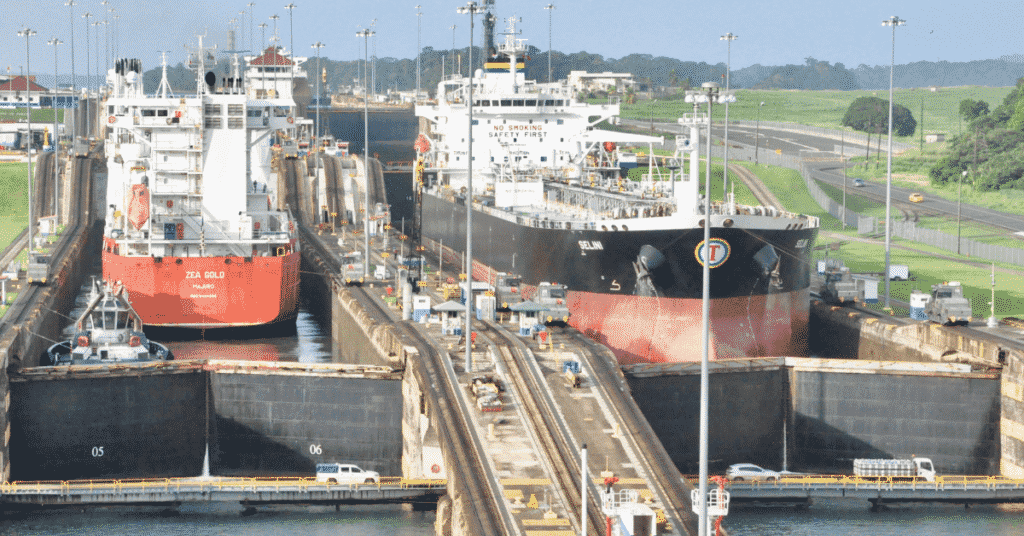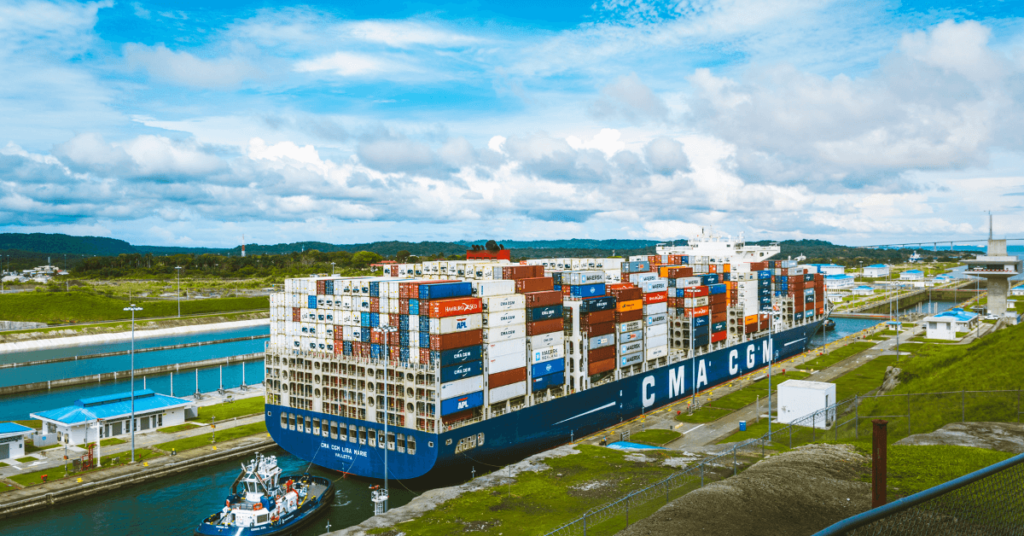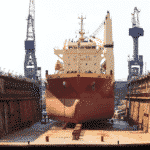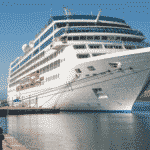Bunkering is Dangerous: Procedure for Bunkering Operation on a Ship
Bunkering procedure is one such operation on a ship which has been the reason for several accidents in the past. Bunkering on a ship can be of fuel oil, sludge, diesel oil, cargo etc. Bunkering of fuel or diesel oil requires utmost care and alertness to prevent any kind of fire accident or oil spill.
In this article we will learn about the bunkering procedure on a ship and what are the important points that are to be taken into consideration while bunkering.
What Does The Word “Bunker” Mean?
The word “Bunker” is used extensively in defence forces and is used to define an area to store and safeguard personnel and supplies (such as fuel, ammunition, food etc.). It was derived from a Scottish word “Bunk” which means a reserved seat or bench.
In the shipping industry, the word bunker is used for fuel and lube oils, which are stored on a ship and used for machinery operation only. If a vessel is carrying marine fuel or lube oil to discharge it to another port, it will not be called “bunker”. If the vessel or truck is carrying it to transfer to another ship for using in its machinery, it will be termed as “bunker” and the operation performed to transport the oil is known as “bunkering”.
Hence, bunker fuel or bunker oil on a vessel are marine fuel/ lube oils which are carried on separate storage tanks, popularly known as bunker tanks for consumption in ship’s machinery.
Related Read: Practical Tips For Bunkering and Storage of Fuel Oil On Ships
Types of Bunker Fuel:
When the ship receives any kind of oil for using it in its machinery it is called a bunker fuel or bunker oil. Following are different types of bunkers which are supplied to a commercial or passenger vessel:
– Heavy fuel oil bunker
– Diesel oil bunker
– Marine Gas oil bunker
– Lube oil bunker
– LNG fuel bunker
Ways to receive Marine fuel Bunker
The bunker fuel can be supplied to a cargo ship in different ways. The mode or method may vary depending upon the grade or type of fuel being delivered to the vessel. There can be different types of bunkering facilities which supply the required marine fuel or lube oil to the ship. A small barge or ship carrying bunker fuel can be used to transfer marine fuel oil (such as heavy fuel oil) to the vessel. If the quantity of oil is less (e.g. lube oil or MGO, LNG etc.), it can be supplied to the vessel using trucks.
Related Read: Important Points to Consider While Providing Marine Bunkering Services
Bunkering Operation Procedure
The bunkering procedure on a ship can be divided into three important stages:
- Preparation– Preparing for the bunkering operation which will involve the readiness of bunkering equipment, storage tanks and bunkering safety
- Perform– Performing the bunkering operation in real time as per the pre-decided procedure and receiving the marine fuel according to the bunker plan
- Wrap-up– Wrapping up the bunkering operation with utmost safety and ensuring the correct amount and quality of bunker fuel has been received onboard from the bunkering facilities (bunker ship or shore truck etc.)
Before Bunkering Operation
1. The chief engineer should calculate and check which bunker oil tanks are to be filled after he/she receives confirmation from the shore office about the amount of fuel to be accepted.
2. It might be required to empty some tanks and transfer the oil from one tank to other. This is required to prevent the mixing of two oils and prevent incompatibility between the previous oil and the new oil.
3. The sounding of other fuel storage tank (not be used in bunkering operation) should also be taken to keep a record of fuel already present onboard. This will help the ship’s officer in case any valve is leaking, and the bunker oil is being transferred to the unwanted tank.
Related Reading: Sounding and Different Methods of Taking Sounding on a Ship
4. A meeting should be held between the members that will take part in the bunkering process, and they should be explained about the following:-
- Which tanks are to be filled
- Sequence order of tanks to be filled
- How much bunker oil is to be taken
- Bunkering safety procedures
- Emergency procedure in case oil spill occurs
- Responsibilities of each officer are explained
5. Sounding is taken before bunkering and record is made
6. A checklist is to be filled so that nothing is missed
7. All deck scuppers and save all trays are plugged
8. An overflow tank is provided in the engine room which is connected to the bunker tank and bunker line. Ensure the overflow tank is kept empty to transfer excess fuel from the bunker tanks
9. Adequate lighting at the bunker and sounding position are to be provided
10. No smoking notice should be positioned near the bunkering station
Related Reading: Ultimate Guide to Fuel Oil Bunkering Process on Ships
11. Onboard communication, signs, and signals to stop the operation between the people involved in bunkering are to be understood by all the crew involved in the operation.
12. Red flag/light is presented on the masthead
13. Opposite side bunker manifold valves are closed and appropriately blanked
14. Vessel draught and trim is recorded before bunkering
15. All equipment in SOPEP(shipboard oil pollution emergency plan) locker are checked and kept near the bunkering station
16. When bunker ship or barge is secured to the ship side, the person in charge on the barge is also explained about the bunker plan
17. Bunker supplier’s paperwork is checked for the oil’s grade and the density if they are as per the specification
18. The pumping rate of the bunker fuel is agreed with the bunker barge/ bunker truck
Related Reading: What is Cappuccino Bunker Effect On Ships?
19. The hose is then connected to the manifold. The condition of the hose must be checked properly by the ship staff and if it is not satisfactory, same to be notified to the chief engineer
20. Most of the bunker supplier send there crew to connect the bunker oil pipeline coming from bunker ship/ barge. The ship staff must recheck the flange connection to eliminate the doubt of any leakage
21. Once the connection is made, the chief engineer will ensure all the line valves which will lead the bunker fuel to the selected bunker tanks are open, keeping the main manifold valve shut
22. Proper communication between the barge and the ship is to be established
Related Reading: What is Ship-Shore Interface Management in the Shipping World?
23. Sign and signals are to be followed as discussed in case of communication during an emergency
24. Most bunkering facilities (ship/ barge/ terminal/ truck etc.) provide an emergency stop switch which controls the bunkering supply pump. Ensure to check its working before commencing the operation
25. Once all the checks are done, the manifold valve is open for bunkering
Before Bunkering Operation Checklist
During Bunkering Procedure
1. During the start of the bunker, the pumping rate is kept low; this is done to check that the oil is coming to the tank to which the valve is opened
2. The ship staff must track the sounding of selected bunkering tank and other tanks which are not involved in the operation to ensure oil is only going to the selected tank
3. After confirming the oil is coming to the proper tank, the pumping rate is increased as agreed before
4. Generally, only one tank filling is preferred because gauging of more than one tank at a time increases the chances of overflow
5. The max allowable to which tank is filled is 90 %, and when the tank level reaches about to maximum level, the barge is told to pump at low pumping rate to top up the tank, and then the valve of other tank is opened
6. During bunkering, sounding is taken regularly and the frequency of sounding is more when the tank is near to full. Many vessels have tank gauges which show tank level in the control room, but this is only to be relied upon if the system is working correctly.
Related Read: How and Why to Take Manual Sounding On Ship?
7. The temperature of the bunker oil is also to be checked; generally, the barge or supplier will provide the bunker temperature. Temperature is a critical parameter, especially for bunker fuel such as heavy fuel oil, and any deviation in the provided temperature value may lead to a shortfall in bunker supply
8. A continuous sample is taken during bunkering with the help of sampling cock at the manifold
9. The crew needs to switch (open and close the valves) the internal storage tanks to accommodate the quantity of the bunker oil being supplied. Utmost precaution needs to be taken when opening the other storage tank valve and closing the valve of the tank which is reaching the maximum fill limit.
During Bunkering Operation Checklist
After Bunkering Procedure: Wrap-up
1. Once the bunker is finished, it is a general practice to air blow the bunkering supply line for discharging all the oil trapped in the pipelines. At this stage, ensure all sounding pipe caps are closed and keep a watch on those storage tank vents which are at its maximum limit.
2. Avoid opening the bunkering supply line connecting between bunker ship and receiving manifold. In case of any discrepancy, the supplier may agree to compensate the shortfall and may resume bunkering operation
Related Reading: 13 Malpractices In Bunkering Operations Seafarers Should Be Aware Of
3. Draught and trim of the ship is checked
4. Take sounding of all the tanks bunkered
5. The volume bunkered should be corrected for trim, heel and temperature correction
6. In general, for each degree of increase in temperature the density should be reduced by 0.64 kg/m3.
Related Read: 3 Important Calculations Every Marine Engineer Must Know
7. Four samples are taken during bunkering. One is kept onboard, one for the bunker ship or barge, one for analysis, one for port state or IMO
8. The chief engineer will sign the bunker receipt (BDN) and the amount of bunker received
9. If there is any shortfall of bunker received the chief engineer can issue a note of protest against the barge/supplier (in case the deficit is not agreed by the bunker supplier)
10. After everything is settled, the hose connection is removed
11. The sample is sent for laboratory analysis
12. The chief engineer will make the entry of the operation in oil record book along with received BDN
12. The new bunker should not be used until the report from the lab
After Bunkering Procedure Checklist
Over to you..
Do you think any point related to bunkering operation needs to be added to this procedure?
Let’s know in the comments below.
Disclaimer: The authors’ views expressed in this article do not necessarily reflect the views of Marine Insight. Data and charts, if used, in the article have been sourced from available information and have not been authenticated by any statutory authority. The author and Marine Insight do not claim it to be accurate nor accept any responsibility for the same. The views constitute only the opinions and do not constitute any guidelines or recommendation on any course of action to be followed by the reader.
The article or images cannot be reproduced, copied, shared or used in any form without the permission of the author and Marine Insight.
Do you have info to share with us ? Suggest a correction
Latest Shipboard Guidelines Articles You Would Like:

About Author
An ardent sailor and a techie, Anish Wankhede has voyaged on a number of ships as a marine engineer officer. He loves multitasking, networking, and troubleshooting. He is the one behind the unique creativity and aesthetics at Marine Insight.
Subscribe To Our Newsletters
By subscribing, you agree to our Privacy Policy and may receive occasional deal communications; you can unsubscribe anytime.






















Thanks for the info
Man, talk about a fantastic post! I?ve stumbled across your blog a few times within the past, but I usually forgot to bookmark it. But not again! Thanks for posting the way you do, I genuinely appreciate seeing someone who actually has a viewpoint and isn?t really just bringing back up crap like nearly all other writers today. Keep it up!
thanking you, I need much more things like this,,
nice explaination ‘ very helffull, keep it up
very helpful to carry out our job in a healthy manner……… thank you
great …..
Don’t know if this is the right forum but I’ll give it a try.
Any opinion on using Dynamic Positioning instead of mooring lines during bunkering operations?
I think it will be wise to check the soundings in the barge tanks. It might be helpful in case of dispute.
Another interesting issue to discuss is about the tricks suppliers can try on us. Sometimes they are quite motivated to do that.
hmm mostly bunkering operations have difference this is connected with direct place were bunkering was done, africa is one case europe is enother, we never should forget that supplier almost always chittering)))
useful info.
it is a dangerous job…
Good day,
I’ve just subscibed to your site because i found it very intersting and hopeful.
Thank You EL Mazouni.
nice explaination ‘ very helfull sir thank u so much..
Nice sir g, your thinking is good.
I hope u will sure sucess.
Thanks
Good Day
Thanks for this information but I hope to inform us about safety during bunker.
Dear Yasir, Do check the following link for more information on bunkering: https://goo.gl/rKPD1a
thanks. I really thankful to you
Thant was helpful to me as a cadet
can you explain to me what is topping up during bunkering?
@Racid: Topping up is actually the rate at which the fuel is supplied to the ship. Since the tank is about to reach the required sounding, the topping up rate is reduce to avoid any oil spill/ blow from the sounding pipe or tank vent
Can you explain to me why high temperature will result to shortfall
On wich dokument can I refer to the maximum of FO intake 90%? If i have order to get 96%.
@Sergii.
90% is a just to mention the safest limit to avoid any spill due to list/trim of the ship or air blow from bunker barge. You can receive up to 98% of the fuel if the operation is properly monitored. For more guidelines on the bunker, please check RESOLUTION MEPC.122(52)
are the steps of bunkering universal?
What is the min. distance from coast or ships to start bunkering ship to ship?
Thank you it helps a lot.
@Jhoniel: Glad the content is helpful 🙂
Great insight. I’m very new to the industry and would like to know how I can be more efficient and reach my highest potential in bunkering sales.
A well briefed topic. Help to mariners.
Appreciated your approach to share marine related knowledge, and i feel these sharing are upto a considerable standard
what follow up actions we have to take in regard to disputes in the quality and quantity of bunker received?
@Lakshay: You need to issue a NOP as this one is an official document to acknowledge the dispute.
https://www.marineinsight.com/careers-2/free-sample-note-of-protest-for-bunkering-disputes/
Please send line diagram how to take bunker in a ship From a barge
What is bunkering procedure including normal pressure/temperatures
kindly explain in details bunkering procedure including normal the pressure/temperature
thanks!
Please can you chose after transferring the oil to ashore station you should complete the following
1- oil record book or 2-ships log or 3-ships log and oil record book
Which pump are used for bunkering and why ?
What distance from shore is allowed to do bunkering? Where can I find that information? Thank you
@Ana: There is no distance requirement as bunkering can be done when the ship is ar anchor or when the ship is standing in a port.
Hello Anish, Great post. very helpful.
Where do I find the regulations in regard to Bunkering? Seem to be stuck trying to find any. I have tried Annex 1 and IMDG code. What am I missing? feel like its right in from of me and i can’t see it. haha
@Cam: Have you seen the BIMCO and IBIA guidelines which follows the industry standards – https://www.cbi.dk/brochures/IBIA%20BIMCO%20Bunkering%20Guide.pdf
Thanks Anish, again very helpful.
@Cam: Glad I can be of help. Cheers. ????????
Could you explain the detailed about “Procedure for fresh water (drinking water) Bunkering Operation on a Ship” including from shore, water barge and water boat transfer to ship, please?
@Ungcana: We will surely pass on this topic to our editors. Thank you for the suggestion.
great job.
Please share procedure of bunkering in adverse weather and prevent of spillage.
@Jahidur: If the weather is extremely bad, it is advisable to stop the bunkering operation. If the operation can be managed without any issue, ensure:
– To properly secure the barge moored to the ship so that it does not move due to weather conditions
– To properly secure the pipe coming from barge to ship
– To keep an extra wathckeeper in the bunkering station
– Keep a track of sounding levels as ship movement due to bad weather may give a false reading
Good SOP! Note that in US waters there must be a crew member on the delivering vessel with the proper Coast Guard Document – MMD with Tankerman PIC endorsement. On US Inland Waters this is referred to as”Midstreaming” rather than bunkering. In many cases the process is conducted while under way.
@Charles: Thank you so much for the value addition ??
Thanking You your Info. Congratulation …
Thanks I found this very helpful..